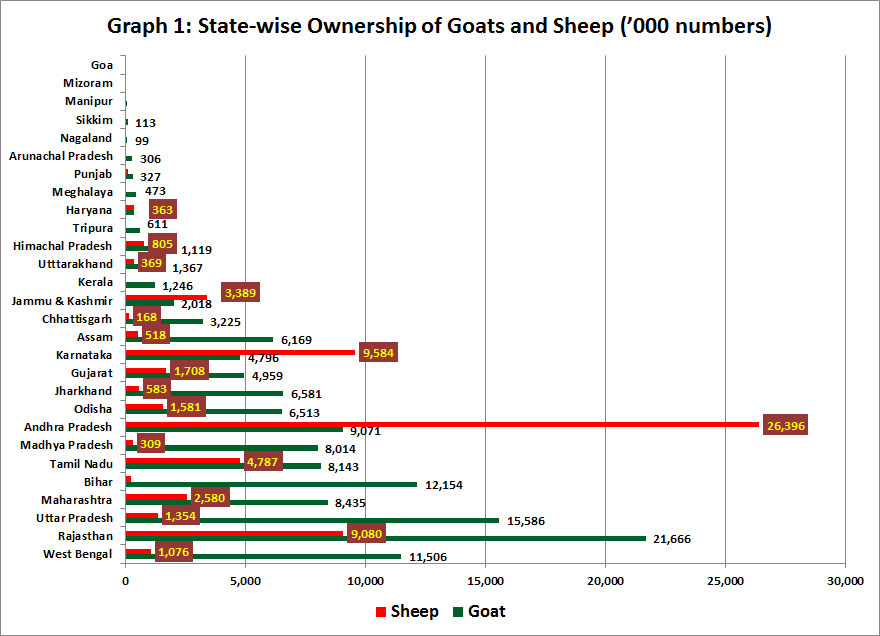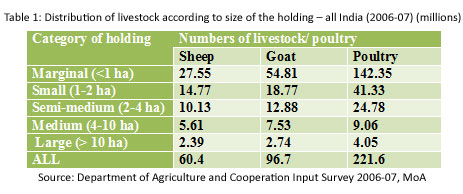Small Ruminant Rearing
Jainul Aabeedin is a goat trader in West Bengal, and his quote (above) brilliantly sums up the fluctuating nature of returns from small ruminant rearing, more specifically from goat rearing.
India supports 16.1% of the world’s goat population and 6.4% of its sheep (FAO Statistics,1 2013), making it among the highest livestock holding countries in the world. Based on the latest GoI statistics (19th Livestock Census, 2012), the number of sheep and goats in the country is 65.06 and 135.17 million, respectively2. The state-wise goat and sheep population in the country is presented in the following graph.

The state with the highest number of goats is Rajasthan (21.6 million), followed by Uttar Pradesh (15.6 million). Sheep rearing is more frequently a feature of the arid and semi-arid regions of western India, the Deccan plateau and the western Himalayas. States with significant sheep populations include Andhra Pradesh (26.3 million), Karnataka (9.6 million) and Rajasthan (9.1 million).
The total number of households and household enterprises3, both rural and urban, which rear/own sheep and goats are 4.55 and 33.01 million respectively. Together, the goat and sheep rearing households constitute 15% of the total number of households in the country4. Similarly, non-household enterprises5 and institutions6 which rear/own sheep and goats are 8,010 and 25,189 respectively.
Small ruminants not only contribute to the household livelihood and nutrition security, but are also a hedge against the losses in agriculture consequent upon the vagaries of nature, and the adversities faced by these families in the absence of adequate health and social security systems.
Traditionally, sheep rearing has been the primary source of livelihood for shepherds, who often belong to distinct communities (for example the Raikas of Rajasthan, Dhangars of Maharashtra, Kurubas of Karnataka). Goat rearing, on the other hand, is a supplementary, support activity for other livelihoods, particularly agriculture. Sheep are reared in relatively larger herds (averaging 60-70) whereas goats are reared in smaller numbers, ranging from 1 to 10, on average. Goat rearing is also characterized by a greater involvement of women, and hence offers an opportunity for empowerment of women through goat-based livelihood improvement.
Statistics published by the Ministry of Agriculture indicate that around 70% of the goat and sheep in the country are reared by small and marginal farmers and landless labourers (refer table 1), and this is corroborated by field findings. Small ruminant rearing is therefore a priority livelihood activity for resource poor farmers, and is often a key support activity for other livelihoods.

SA PPLPP’s documentation of interventions on small ruminant rearing has been clustered around four core themes –
- Breed Conservation and Improvement
- Health Systems, Institutional Arrangements and Collaborative Programmes
- Feed, Fodder and Access to Grazing Lands
- Markets, Value Addition and Facilitating Access to More Remunerative Markets for Small Ruminant Rearers
Major challenges faced in development of livelihoods based on small ruminants, that have emerged from SA PPLPP’s documentation on small ruminant rearing are described in the following paragraphs.
Veterinary care
- Characterized by failure of small holders to access essential livestock services, including preventive veterinary care; preliminary investigations suggest mortality rates as high as 30-40% in goats and goat kids.
- Vaccines for major diseases (such as PPR) are either not available in adequate numbers, or the cold chain supply systems are not adequately maintained, affecting the efficacy of the product.
- In most states, there is a virtual absence of para-veterinary and extension services at the village level; the government veterinary system reaches only up to the Block level and is inadequately staffed. Para-vets and community animal health workers, trained by both NGOs as well as under government programmes, have demonstrated their worth in last mile service delivery in many states across the country. However, questions around the sustainability and legality of the services provided by these trained para-vets and extension workers still persist.
Shelter and Housing
- Losses on account of predation and climatic variations are a major cause of mortality and morbidity, and could be avoided through appropriate housing and shelter, which is seldom accorded priority.
- MGNREGA: Schedule I and II of the Act were amended (2012) to include construction of poultry sheds and goat shelters as permissible works, but are not usually included in the approved shelf of activities at the district and/or state levels.
- Low-cost, eco-friendly and goat-considerate alternative models have been developed and are being propagated by SA PPLPP.
- GO-NGO collaboration is crucial to leverage advantages of government schemes for benefit of the smallholder livestock rearers, and this requires allocation of sufficient financial resources not only for the service delivery but also for community mobilization and sustainability of benefits.
Breed conservation and availability of bucks
- Given the structure of the market and its operations, the best quality bucks end up in abattoirs, resulting in non-availability of good quality breeding bucks and rams in sufficient numbers. There have been limited attempts, if any, at either government or community levels, for identification, recognition and conservation of germplasm of superior bucks.
- There is a lack of good quality and reliable data on small ruminant numbers and breed populations, trends over time and the drivers of these trends. It is necessary that such data is collected and analyzed periodically to establish the reasons for the increase or decrease in the numbers of specific breeds. This will also help in identifying breeds that are at the greatest risk of extinction.
- The majority of sheep and goats in India belong to ‘un-described’ (usually referred to as non-descript) breeds or they are ‘local’ animals not necessarily belonging to a distinct, ‘recognized’ group or breed. The focus on ‘breed improvement’ through cross-fertilization with superior and recognized breeds needs to be complemented with appropriate measures for recognition of indigenous breeds, and conservation in their native breeding tracts. There is an urgent need to support establishment of Breeders’ Associations for conservation of indigenous breeds in their native tracts.
Grazing and fodder resources
- Loss of designated grazing lands, closure of forest areas, and diversion of common lands for other purposes has intensified pressure on available resources, leading to their degradation.
- There has been an erosion of synergies between agriculture and animal husbandry due to an interplay of various factors, making small holder rearers’ livelihoods more vulnerable.
- Reduction in grazing lands, encroachment of common lands, and increasing industrialization have adversely affected small ruminant rearing, which used to be a highly productive low-input system dependent on these lands for fodder and grazing resources.
Livestock markets
- Local livestock markets are auctioned by Panchayats/ local committees, and managed by contractors; there are hardly any government regulations and little intervention, if any, in the establishment, upkeep or management of these markets.
- Transactions in the livestock trade are non-standardised and one comes across numerous unfair trade practices because of the ad-hoc nature of the market. Animals are sold on the basis of a visual estimation of their weight, age and appearance; transactions remain unrecorded and unreported, resulting in loss of potential taxes/revenue to the government, which could go towards development of livestock market infrastructure.
- Small ruminant markets are structured in favour of intermediaries, to the disadvantage of the consumer, rearer and the by-products markets. The market has developed in a manner that clearly puts the rearer at a disadvantage; however it is not even a buyer’s market. It will not be inappropriate to state that the meat market is ruled by traders, brokers and commission agents.
- The operational focus on meat to the exclusion of all other by-products obtained from small ruminants manifests in poor price realization for the rearer; except where operations have been modernized and mechanized, there is a lot of wastage, and in-efficient collection and utilization of by-products.
- There is virtually no value addition that takes place along the value chain from producer to consumer, even though the price of the commodity keeps increasing at each stage along the channel. In the meat industry, intermediaries’ gains are on account of economies of scale and market location.
References:
- FAOSTAT - http://faostat.fao.org/site/291/default.aspx
- 19th Livestock Census 2012, Department of Animal Husbandry, Dairying and Fisheries, Ministry of Agriculture, Government of India
- A household enterprise is one which is run by one or more members of a household or run jointly by two or more households on partnership basis irrespective of whether the enterprise is located in the premises of the household or not.
- Census 2011 figures used for total number of households (=246,692,667)
- A non-household enterprises is one which is institutional i.e. owned and run by the public sector (Central or State Government, local bodies, government undertakings, etc.), private corporate sector (include public and private limited companies registered as joint stock companies under the Companies Act 1956), Co-operative societies, other type of societies, institutions, associations, trusts, etc.
- For the purpose of the 19th Livestock Census, Temples, Mosques, Gurudwara, etc. have been covered under Institutions.









